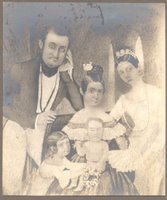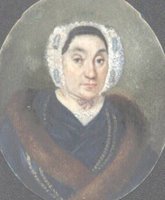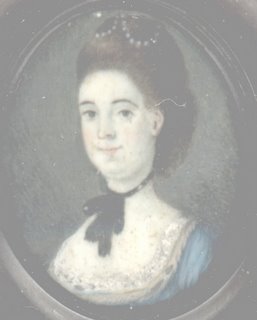
Shown here is a group of portraits associated with Antonio
Meucci (Anthony
Meucci) (?-1852). They have been kindly supplied by a
descendant of
Meucci, together with most of the information contained here. It therefore provides an opportunity to record some information about this artist who is not well known. The first one shown may well be a self portrait of the artist, or failing that a portrait of him by his wife Nina Meucci who was also a miniturist.
Meucci arrived in the United States from Rome, Italy in 1818 and worked in various American cities including New York, Portland (Maine), Richmond, Baltimore, Charleston, Salem MA, and New Orleans. His wife Nina was also a miniature painter and in 1824 they exhibited four miniatures at the American Academy of Fine Arts. While in Charleston they advertised that they could teach young ladies to paint figures, landscapes and miniatures in fifteen weeks.
Meucci returned to New Orleans from Salem MA in 1826-7 and it seems that his last work in New Orleans was as a scenery and backdrop painter at the opera.
Julien Hudson (Jules Hudson (?-1844) a black American was perhaps the first and only African miniaturist in USA before the Civil War and was a pupil of
Meucci in New Orleans 1n 1826-7.
References have been found to a Anthony
Meucci who lived in New York and was a stage painter. Antonio
Meucci lived in that city and did this work in New York and elsewhere. As both also lived briefly in Cuba, it seems certain they were the same person.

The
Meucci's left USA for good in 1827 heading for Havana Cuba. The next information known about
Meucci is that he arrived in
Cartagena, Colombia from Kingston, Jamaica about the middle of 1830 where he saw the very sick Simon Bolivar marching into town. While there
Meucci painted a miniature portrait of Simon Bolivar, which is considered the last portrait of Bolivar painted from life.
Meucci painted about 12 copies of this portrait. One of the portraits can be seen at
www.museonacional.gov.co/body_propaganda.html For more about Simon Bolivar see
Simón Bolívar - Wikipedia, the free encyclopedia Meucci painted widely in South America until 1837 and died before 1852 in Lima or Guayaquil.

The portraits displayed include a family group (although this looks like a
photograph, it is not a photograph, as can be seen from an enlarged version by clicking on it), which shows Richard
Souter, formerly of Scotland, together with his wife Sabina
Meucci (1805?-1884), who was the daughter of Antonio
Meucci. Also in the group is
Rosalba Huerta
Meucci the daughter of Sabina by a previous marriage, so she must have been a widow. Richard
Souter was either a diplomat or merchant in Colombia and may have drowned in a shipwreck in 1841 near Liverpool.The two small children in the group portrait are the owner's great grand aunt Helen
Souter, who later married William
Waddington in Chile and the baby is his great grand father Frederick
Souter Meucci 1837 - 1876 who is buried in Valparaiso, Chile. The owner deduces that the portrait was drawn in
Cartagena, Colombia in early 1838. However, it is not certain the portrait was drawn by Antonio
Meucci, and may even be by Nina
Meucci.


The three miniature portraits and one engraving of young ladies are all believed by the family to be portraits of Nina
Meucci, made by
Antonio. The lady in a white dress and wearing a miniature is wearing a shell comb that looks to be the same as the one in the engraving of Nina. The lady in green is signed
Meucci on the left. The lady wearing the mantilla headdress is signed on the left "Nina
Meucci by A
Meucci 1822". The engraving of Antonio
Meucci's wife shown here, is inscribed at the bottom "Signora Nina
Meucci - Drawn on Stone from the Life by A
Meucci". Nina was also a miniature painter.

On 27 February 1834
Meucci was advertising in a Lima, Peru newspaper offering to paint miniatures and natural sized portraits in oil. In the advertisement, he also offered to draw imitation engravings on ivory paper. Thus the portrait of his wife may be one of these, despite the statement that it is drawn on stone.
The owner of these portraits kindly allowed these portraits to be shared after seeing the portrait in this collection which is by Antonio, see
Meucci, Antonio - portrait of a man and shown here as the man with a striped waistcoat.

There are also several portraits by
Meucci in the New York Historical Society Collection, the Museum of New Orleans, and one in the
Manney Collection.
Most of the following additional comments about his career have been also kindly supplied by the descendant of
Meucci who owns these portraits.
The history of
Meucci is typical of
itinerant miniature painters. He entered the United States from Europe, arriving at cities where there were established artists. Additionally, it is probable that his command of English was initially limited. Thus he was not well placed to build up a
clientele where miniatures could generally only be afforded by the well off or professional classes, who were a small minority of the community. Then, as now, paintings by established artists, were preferred, and once a couple had their own portraits painted, there was little opportunity for a painter to expect repeat business. Thus his gradual drift southwards, is a sign he was seeking new clients, as the following records show. The Spanish language is closer to Italian than English, which may have been an additional benefit that Meucci could exploit, whereas native English speaking artists from the USA tempted to move South to seek work, would have found the Spanish language a barrier.
 MEUCCI
MEUCCI IN COLOMBIA
1828
Meucci is believed to have made a trip to Bogota
1830 in
Cartagena from Jamaica, when he painted Bolivar
1831
Rionegro1832? Medellin
1832
Popayan in the South of Colombia, in his way to Peru
These trips can be followed by the trail of his paintings and comments made about him, as in the following quotation in "
Papel Periodico Ilustrado" Year II page 411 by Alberto
Urdaneta. "in those days decorative arts did not shine in these countries, which were devoted to the glories of
Belona. We know nothing of the biography or
aesthetic studies of the Italian
Meucci, nor why or when he came to Colombia. If we can judge him by the works he left us, he was not an outstanding miniaturist, but an artist of spirit, because with love and eagerness he reproduced many times the image of "The Liberator".
The reason
Meucci left Bogota, Colombia, is apparently
because he had a quarrel and left Bogota hurt by the sarcastic, but perhaps correct criticisms of the acknowledged miniaturist Don Jose Maria
Espinosa. The conflict between
Meucci and
Espinosa who were both painters of Bolivar, may have been because
Meucci made copies of an original work by
Espinosa. In fact many of
Espinosas supposed originals are now considered to be the work of
Meucci.

There are sometimes harsh
criticisms of his work. In "
los retratos de Bolivar" by Alfredo
Boufton, there is the comment "A.
Meucci was one of Bolivar's painters with the least realism. His drawing is often imperfect and his brush of a reduced and poor
impression and colour blending".
Meucci was in
Popayán in the South of Colombia in 1832 and he traveled from there to Lima Peru. It is likely that he made his trip by land to Quito-Ecuador and then to the port of Guayaquil, where he traveled by sea to the port of Callao and then to Lima where he lived several years. It was impossible to travel by land from Ecuador to Peru in those years.
Meucci published in “The
Mercurio Peruano” newspaper, on September 7, 1833 and then on October 18 and 19 the same advertisement, in a slightly
archaic Spanish:
ANNOUNCEMENT TO THE PUBLIC. "Antonio
de Meucci, portrait painter native from the city of Rome, has the honor to inform the most respectable public, that he has moved his studio to the corner of the small plaza of Saint Augustine, in the second floor of Mr.
Blanco’s well known house, where the carpenter's shop is located. The many portraits that have been ordered, and the favorable reception that his works has attained in this city, makes him cherish the hope that he will be hired from now in the future, as he has been up till now in the practice of his art. A collection of his portraits are displayed in one of the parlors of the mentioned house and can be seen by the persons who would like to hire him. It is informed that ladies portraits will be perfectly finished in three days, taking the trouble of only half an hour each day, in whose homes he will attend at the agreed hour: and those of gentlemen will be completed in two days posing half an hour a day."
It is likely the collection of portraits, which he refers to in the advertisement, includes the miniatures of Nina
Meucci shown above.
MEUCCI IN PERU
Meucci placed advertisements in several newspapers in Lima offering his
services. In "El
genio del Rimac" (newspaper) Lima 27
February 1834. "Don Antonio
de Meucci Roman portrait painter offers his
services to this respectable public in painting miniatures and also portraits of natural size. He also offers a new method of painting on ivory paper
imitating engraving. Its cost will be only 12 pesos" etc etc.
Meucci was in Lima till 1834 and left for Guayaquil where he is thought to have lived for several years. In Guayaquil he trained the
Peruvian painter
Quispe (which is an Indian name). He was back in Peru in 1837 when he sold in Lima to the British
Ambassador Dr.
Bedford Wilson an unfinished portrait of Bolivar. Wilson added at the back with his own hand: "This is the best and only good interpretation of General Bolivar."
Bedford Wison was a British (perhaps Irish?) officer on the staff of Simon Bolivar, where he was a trusted and close aide-
de-camp. When Bolivia declared independence, Bolivar wrote its Constitution and
commissioned Wilson and another English officer to carry the
document to Bolivia in a trip of 1800 miles.
Another quotation about
Meucci is found in an Internet Biography of Jose Maria
Espinosa. "He was very
prestigious in Lima by 1840 as the
scenographer of an Italian Opera Company. His trail can be followed in Lima until about 1847". In 1843
Meucci's daughter Sabina
Meucci, probably a
widow, was in Lima as teacher of drawing and piano at the School of Santa Cruz
de Atocha, a school for orphan girls. In 1845 Sabina was the principal of the "
Colegio de Educacion del Espiritu Santo" (Educational College of the Holy Ghost) located in
Miraflores, an elegant summer resort very near Lima.
It seems
Meucci lived at least 15 years in Ecuador and Peru, much more than in Colombia or the United States, but has left no knowledge of any miniature or painting in this period.
Meucci must have died between 1847 and 1851. It is presumed in Guayaquil, because Frederick
Souter Meucci, the great-grand-father of the current owner attended school there. Sabina and her children migrated to Valparaiso Chile where her daughter
Rosalba Huerta
Meucci was living with her husband Manuel
Belinfante.
The cost of his portraits has been deduced in the following manner. It appears that the price of the early newspaper The
Mercurio Peruano's" was one Real and 8
Reales is believed to equal one Peso. So if .as mentioned above,
Meucci charged 12 Pesos for one of his miniatures, that would make 12x8 = 96
Reales per portrait. As a newspaper now currently costs about $1 American dollar,
Meucci would have earned about $100 dollars per portrait in present day values.
Meucci informed his clients that it would take one and a half hour for a lady to pose and a gentleman one hour in two
sessions. This means that
Meucci could easily paint 20 portraits a month if he had the clients, earning about $2,000, a month in present day values, which while not high, seems a reasonable estimate.
Santiago had a population of about 40,000 in
Meucci" time and Lima could not have had more than 100,000 inhabitants. However, 90% of this population was poor and uncultured and had no interest in miniature painting. This means that
Meucci had to work with a very small possible client population not more than 5000-10000 persons in the biggest cities. To make things worse for him, much of this limited population was babies and children, and other painters were working simultaneously.
Earlier thoughts had been that
Meuuci was a kind of nomadic soul who worked in at least seven cities in USA in ten years, and painted in at least six cities in Colombia in two years, as well as other places in Central and South America. However, the reason for his wandering appears clear. If
Meucci could paint easily 200 portraits a year, in a very few months he would run out of clients. Thus his wanderings were the results of a demographic problem, not the quality of his paintings, nor of his character. This probably also why he sought work as a scenery painter in many places.
The Other Antonio Meucci
As there is sometimes a little confusion with another Antonio Meucci who invented the telephone, the following are some details about him. This other Antonio Meucci (1808-1889) was an immigrant from Florence, Italy, who arrived in New York in 1835. It is a little difficult to track him through the census records, but his wife's name Esther is a clue. In the 1850 census he described himself as "Gentleman" and his place of birth is recorded as France, probably because the census taker misheard the word Florence. In 1860 he seems to be recorded as Antonio Mcio, a foreman in a candle works and he had a servant Mary Taney, presumably to look after his wife. His name is not obvious in later census records. When his wife, Esther, became paralysed in the 1850's he rigged a system to link her bedroom to his workshop. He held a public demonstration of his invention in New York in 1860, but was unable to aff0rd the $250 patent. In 1871 he filed a one-year renewable "notice" of an impending patent, but could not afford to renew it. Then in 1876, Alexander Graham Bell, who shared the laboratory with Antonio Meucci and thus had access to his work, successfully filed a patent for a telephone. Meucci sued, but the legal action ceased on Meucci's death in 1889. However, in June 2002, the United States Congress finally recognised Meucci as the father of communications.
 An interested visitor from Lancaster PA, USA has sent me this image and information about this miniature portrait of Jacob Westhaeffer (1818-1895) by John Henry Brown, which is helpful as another indication of his painting style.
An interested visitor from Lancaster PA, USA has sent me this image and information about this miniature portrait of Jacob Westhaeffer (1818-1895) by John Henry Brown, which is helpful as another indication of his painting style.


















































 The three miniature portraits and one engraving of young ladies are all believed by the family to be portraits of Nina
The three miniature portraits and one engraving of young ladies are all believed by the family to be portraits of Nina 


